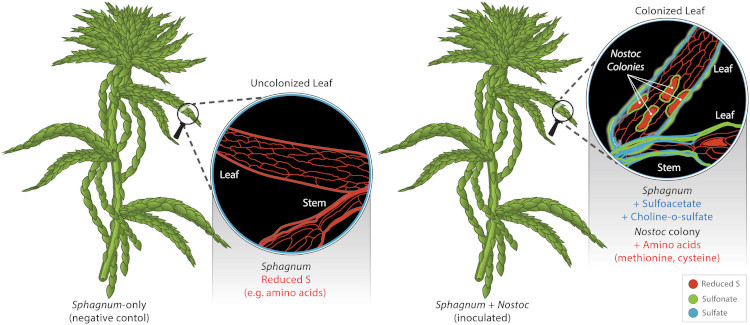Sulfur Exchanged in Peat Moss-Cyanobacteria Mutualism
12/22/2023

Understanding the role of peat moss in peatland ecosystem sulfur dynamics. Conceptual diagram of sulfur speciation in stem and leaf tissue of Sphagnum angustifolium peat moss with hyaline cells that are either uncolonized or colonized by the cyanobacterium Nostoc muscorum.
[Reprinted with permission from Weston et al. 2023. New Phytologist, DOI:10.1111/nph.19476. Copyright 2023 John Wiley and Sons.]
The Science
Peatland ecosystems greatly impact terrestrial carbon and nitrogen processes, occupying 3% of the Earth’s land surface and storing approximately 25% of terrestrial carbon as recalcitrant organic matter (OM). Sphagnum, a key peat moss genus and producer of recalcitrant OM, is responsible for much of the primary production in these ecosystems. Its growth and productivity depend on symbiotic associations it forms with various microbes, including cyanobacteria.

Fluorescence images showing sulfur speciation in Sphagnum angustifolium leaves colonized by cyanobacteria. [Reprinted with permission from Weston et al. 2023. New Phytologist, DOI:10.1111/nph.19476. Copyright 2023 John Wiley and Sons.]
The mutualistic peat moss-cyanobacteria relationship appeared to at least temporarily increase oxidized sulfur compounds within Sphagnum tissues that subsequently undergo anaerobic decomposition in saturated peat soils. Additional studies are needed to determine the role of sulfur exchange in driving ecosystem-scale sulfur, nitrogen, and carbon dynamics.
The Impact
Whether peatland ecosystems continue to serve as net carbon sinks or become carbon sources as a result of climate change will, in part, depend on how Sphagnum-microbe interactions respond to various climate factors. The current understanding of the Sphagnum–cyanobacterium symbiosis is that carbon-rich carbohydrates are exchanged for nitrogen-rich molecules, but this conceptual model appears to be overly simplistic and possibly missing a key role for sulfur.
This study’s observations emphasize the potential importance of sulfur metabolite production by Sphagnum for facilitating symbiotic association with nitrogen-fixers. Future studies could enable a better understanding of how Sphagnum-driven sulfur dynamics influence associated carbon and nitrogen inputs to peatland ecosystems.
The Summary
Sphagnum angustifolium (originally collected in the field) were colonized by Nostoc muscorum by first adding N. muscorum to a 12-well plate. S. angustifolium gametophytes were placed in a fitting cell culture insert and then placed in a Nostoc-filled well for colonization. Experiments ended after 14 days and each leaf was examined under an epifluorescence microscope equipped with a green (to show plant material) and red (to show cyanobacteria) excitation filter. Percent colonization was quantified as the percent of S. angustifolium hyaline cells occupied by N. muscorum. Samples were prepared for X-ray analysis by rinsing each leaf (or in some cases leaf clusters) in deionized water, then gently placing each sample onto a microscope slide and covering with sulfur-free tape prior to shipping to the Stanford Synchrotron Radiation Lightsource (SSRL). At SSRL, the sulfur-free tape was gently removed with the leaf adhered to the tape, and the tape was loaded onto a sample holder for analysis at beamline 14-3. For each sample, multiple-energy (ME) maps across the sulfur K-edge were collected over the entire life (or cluster) to map the spatial distribution of sulfur species. Sulfur XANES spectra were collected across the samples, with spots determined by on-the-fly analyses of ME maps. The data showed the presence of reduced organic sulfur and oxidized sulfonate- and sulfate-containing compounds. The abundance of these sulfur species changed with percent colonization, where an increase in colonization by N. muscorum resulted in an enrichment of sulfur and changes in speciation, with increases in sulfate relative to reduced sulfur and sulfonate. At the scale of individual hyaline cells, colonized cells exhibited localized enrichment of reduced sulfur surrounded by diffuse sulfonate, similar to observations of N. muscorum colonies alone.
Funding
Use of the SSRL, SLAC National Accelerator Laboratory, is supported by the DOE, Office of Science, Office of Basic Energy Sciences under contract DE-AC02-76SF00515. The SSRL Structural Molecular Biology Program is supported by the DOE-BER, the National Institutes of Health (NIH), and the National Institute of General Medical Sciences (NIGMS; P30GM133894). The contents of this publication are solely the responsibility of the authors and do not necessarily represent the official views of the NIGMS or the NIH. JR is supported by supplemental funding from DOE-BER to assist and expand biological and environmental relevant research and users at SSRL. Collection of starting Sphagnum angustifolium was made possible through the SPRUCE project, which is supported by the Office of Science; Biological and Environmental Research (BER); US Department of Energy (DOE), Grant/Award no.: DE-AC05-00OR22725. Experimentation and some analyses were supported by the DOE BER Early Career Research Program. This work was also supported by the ORNL Critical Interfaces Science Focus Area sponsored by the DOE Office of Science Biological and Environmental Research Program. Oak Ridge National Laboratory is managed by UT-Battelle, LLC, for the US DOE under contract no. DE-AC05-00OR22725.
Related Links
References
Herndon, E., J. Richardson, A. A. Carrell, E. Pierce, D. Weston. 2023. “Sulfur speciation in Sphagnum peat moss modified by mutualistic interactions with cyanobacteria,” New Phytologist. DOI:10.1111/nph.19476.
